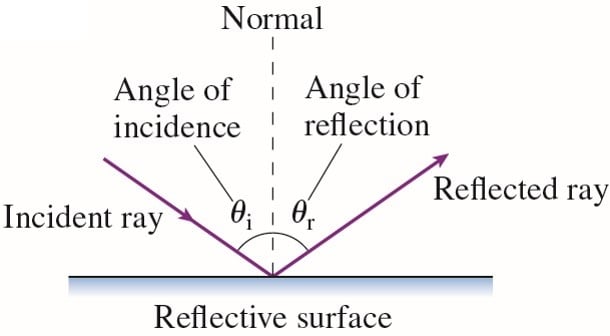The Reflection of Light: Mirrors

Consider a small spherical object whose surface is pulsating in simple harmonic motion. A sound wave is emitted that moves spherically outward from the object at a constant speed. To represent this wave, we draw surfaces through all points of the wave that are in the same phase of motion. These surfaces of constant phase are called wave fronts. If the wave fronts are drawn through the condensations, or crests, of the sound wave, the distance between adjacent wave fronts equals the wavelength $\lambda$. The radial lines pointing outward from the source and perpendicular to the wave fronts are called rays. The rays point in the direction of the velocity of the wave.
Digital lesson: Interactions Of Light
|
|---|
The Reflection of Light
Most objects reflect a certain portion of the light falling on them. Suppose that a ray of light is incident on a flat, shiny surface, such as the mirror. The angle of incidence $\theta_i$; is the angle that the incident ray makes with respect to the normal, which is a line drawn perpendicular to the surface at the point of incidence. The angle of reflection $\theta_r$, is the angle that the reflected ray makes with the normal. The law of reflection describes the behavior of the incident and reflected rays.
The Formation of Images by a Plane Mirror
When you look into a plane (flat) mirror, you see an image of yourself that has three properties:
1. The image is upright.
2. The image is the same size as you are.
3. The image is located as far behind the mirror as you are in front of it.
Digital lab: What Happens When Light Is Reflected?
|
Concept Map: Light
|
|---|
Spherical Mirrors
The most common type of curved mirror is a spherical mirror. A spherical mirror has the shape of a section from the surface of a hollow sphere. If the inside surface of the mirror is polished, it is a concave mirror. If the outside surface is polished, it is a convex mirror.
The Formation of Images by Concave Mirrors
Three specific paraxial rays are especially convenient to use in the ray-tracing method, and these three rays leave from a point on the top of the object.
The Formation of Images by Convex Mirrors
The ray-tracing procedure for determining the location and size of an image in a convex mirror is similar to that for a concave mirror. The same three rays are used. However, the focal point and center of curvature of a convex mirror lie behind the mirror, not in front of it.
Animated Physics: Curved Mirrors
|
Virtual Investigations: Ray Tracing for Mirror
|
Digital simulations: Mirrors and Lenses
|
|---|---|---|
Digital Figure: spherical mirror
|
Digital Figure: rays on a concave mirror
|
Digital Figure: rays on a convex mirror
|
The Mirror Equation and the Magnification Equation
Ray diagrams drawn to scale are useful for determining the location and size of the image formed by a mirror. However, for an accurate description of the image, a more analytical technique is needed, so we will derive two equations, known as the mirror equation and the magnification equation. These equations are based on the law of reflection.
Interactive Demonstration: Imaging with Concave Mirrors
|
Interactive Demonstration: Convex Mirrors
|
|---|
You don`t have permission to comment here!
Report